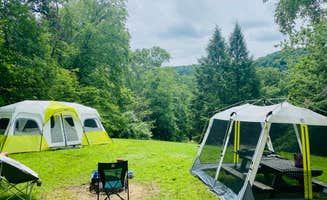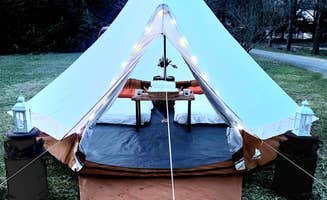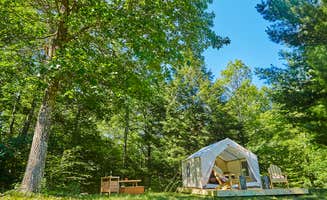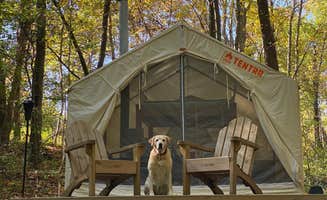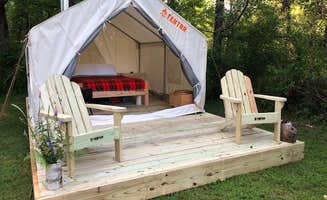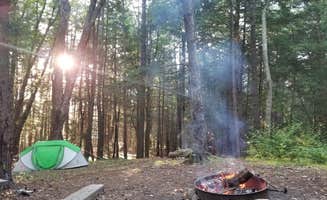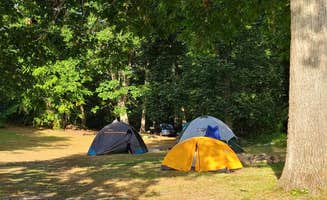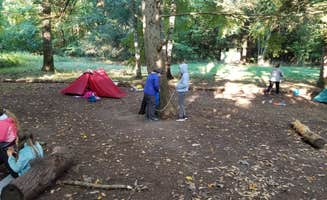Camping near Sandy Hook, Connecticut typically involves a mix of forested sites and water-adjacent options with elevation ranging from 200-1,000 feet. Most campgrounds in the region maintain seasonal operations between April and October, with a limited number offering winter accommodations. Connecticut's western campgrounds feature more varied terrain than coastal sites, creating diverse camping experiences within a 30-mile radius.
What to do
Hiking trails access: Kettletown State Park Campground provides immediate entry to scenic trails with varying difficulty levels. "The shorter hiking trails in the area were really beautiful," notes one visitor to nearby Fahnestock State Park, highlighting the accessible nature walks available to campers. Trails at both parks connect directly to lakeside areas.
Fishing opportunities: Multiple species of panfish and bass inhabit the lakes and ponds throughout the region. At Fahnestock State Park Campground, "our neighbor campers said [the fishing spots] were great for catching panfish - one fisherman said he had caught several bass weighing over 3 pounds!!" The lakes throughout western Connecticut support varied fish populations.
Off-season lake swimming: Some parks maintain beach access for campers even when closed to the general public. "The beach is closed after Labor Day to the public, but open to people staying at the campsite. Clean and beautiful," reports a visitor at Black Rock State Park, making fall camping particularly appealing for water activities without crowds.
What campers like
Large, private sites: Many campgrounds offer spacious accommodations for multiple tents or larger groups. At Ward Pound Ridge Reservation, "The shelter sites are large and private with access to hiking trails and make for a unique experience." Site selection proves crucial for privacy levels at most parks.
Well-maintained facilities: Parks invest in regular upkeep of common areas and amenities. "Bathrooms, water, showers are close by," mentions a Lake Waramaug visitor, while another notes "the bathrooms are always kept clean and stocked and there are a ton of watering spots" at Kettletown State Park.
Wildlife viewing: The region supports diverse animal populations visible from campsites. "We enjoyed playing there, especially chasing the Canadian Geese by the lake," shares a Kettletown State Park visitor, though they caution about seasonal insect activity: "We were there in early June, and were almost eaten alive by mosquitoes when we ventured into the woods."
What you should know
Site variations: Individual sites differ significantly within the same campground. "All sites were so different. There was a storm the night before our arrival date, all campers were evacuated and they did a fantastic job clearing all the debris and downed trees before our arrival," notes a visitor at Clarence Fahnestock State Park.
Bathroom maintenance inconsistency: Facility upkeep varies by season and staffing levels. "The bathrooms and dishwashing... UGH. So old and dirty!!!" reports one camper at Fahnestock, while others note improved conditions during peak season.
Limited cell service: Communication capability varies significantly across the region. "There is no cell phone coverage at any of the campsites," reports a Steep Rock Association visitor, while Lake Waramaug campers note signal availability only at elevated points: "It is possible to get a phone signal up at the 'lookout' of the hike."
Tips for camping with families
Choose kid-friendly sites: Some campgrounds specifically cater to children with open play spaces. "Kettletown State Park Campground has a huge land of campsite that the kids can run around until their energy out for the night! Plus you would see awesome stars during the nighttime!" according to one family visitor who has camped there regularly.
Pack entertainment for varied conditions: Weather changes can limit outdoor activities. "Bring scooters or bikes for little kids to use within the camp," suggests a Lake Waramaug visitor, noting the limited playground facilities at some locations.
Consider swimming area depth: Water access points vary in suitability for different age groups. "The swimming area is an absolute joke, unless you are 18 months old, and then its probably perfect. (Extremely small, extremely shallow, and some sand to dig in)," explains a Lake Waramaug reviewer, highlighting the importance of researching beach conditions before visiting with children.
Tips from RVers
Check site levelness: Many Connecticut campgrounds feature uneven terrain requiring preparation. "Sites are close together so recommend reserving two for more space. Well maintained and secure," notes a Cozy Hills Campground visitor, pointing to the importance of site selection for larger vehicles.
Road gradient considerations: Access routes present challenges for larger rigs. "There are some steep roads in the CG," reports one RVer at Gentiles Campground, while another notes, "roads were narrow and steep and hard to maneuver bigger trailers and rigs."
Plan for limited hookups: Most state parks provide basic services only. "No hookups but I have solar and a generator and they have a wash area for dishes and REALLY HOT showers," explains a visitor to Black Rock State Park Campground, highlighting the need for self-sufficiency in power generation.


